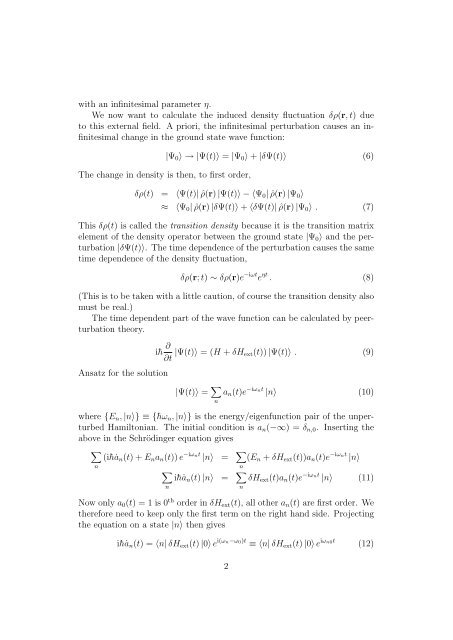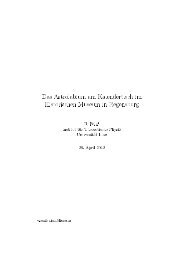Linear response and Time dependent Hartree-Fock
Linear response and Time dependent Hartree-Fock
Linear response and Time dependent Hartree-Fock
You also want an ePaper? Increase the reach of your titles
YUMPU automatically turns print PDFs into web optimized ePapers that Google loves.
with an infinitesimal parameter η.<br />
We now want to calculate the induced density fluctuation δρ(r, t) due<br />
to this external field. A priori, the infinitesimal perturbation causes an infinitesimal<br />
change in the ground state wave function:<br />
The change in density is then, to first order,<br />
|Ψ 0 〉 → |Ψ(t)〉 = |Ψ 0 〉 + |δΨ(t)〉 (6)<br />
δρ(t) = 〈Ψ(t)| ˆρ(r) |Ψ(t)〉 − 〈Ψ 0 | ˆρ(r) |Ψ 0 〉<br />
≈ 〈Ψ 0 | ˆρ(r) |δΨ(t)〉 + 〈δΨ(t)| ˆρ(r) |Ψ 0 〉 . (7)<br />
This δρ(t) is called the transition density because it is the transition matrix<br />
element of the density operator between the ground state |Ψ 0 〉 <strong>and</strong> the perturbation<br />
|δΨ(t)〉. The time dependence of the perturbation causes the same<br />
time dependence of the density fluctuation,<br />
δρ(r; t) ∼ δρ(r)e −iωt e ηt . (8)<br />
(This is to be taken with a little caution, of course the transition density also<br />
must be real.)<br />
The time <strong>dependent</strong> part of the wave function can be calculated by peerturbation<br />
theory.<br />
Ansatz for the solution<br />
i¯h ∂ ∂t |Ψ(t)〉 = (H + δH ext(t)) |Ψ(t)〉 . (9)<br />
|Ψ(t)〉 = ∑ n<br />
a n (t)e −iωnt |n〉 (10)<br />
where {E n , |n〉} ≡ {¯hω n , |n〉} is the energy/eigenfunction pair of the unperturbed<br />
Hamiltonian. The initial condition is a n (−∞) = δ n,0 . Inserting the<br />
above in the Schrödinger equation gives<br />
∑<br />
(i¯hȧ n (t) + E n a n (t)) e −iωnt |n〉 = ∑ (E n + δH ext (t))a n (t)e −iωnt |n〉<br />
n<br />
n<br />
∑<br />
i¯hȧ n (t) |n〉 = ∑ δH ext (t)a n (t)e −iωnt |n〉 (11)<br />
n<br />
n<br />
Now only a 0 (t) = 1 is 0 th order in δH ext (t), all other a n (t) are first order. We<br />
therefore need to keep only the first term on the right h<strong>and</strong> side. Projecting<br />
the equation on a state |n〉 then gives<br />
i¯hȧ n (t) = 〈n| δH ext (t) |0〉 e i(ωn−ω 0)t ≡ 〈n| δH ext (t) |0〉 e iω n0t<br />
(12)<br />
2












